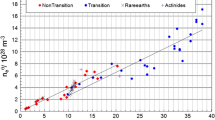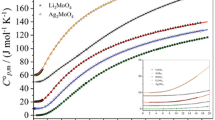Abstract
In this research, a new different method has been proposed to combine the Einstein and Debye models for molar heat capacity at constant volume (cv) in one (mixed) model in order to give results closer to experimental measurements and better than using each model separately, where Debye's notion was adopted for the acoustic branches of the dispersion relation and Einstein's notion for its optical branches, and, so, the integration resulting from this mixed model was solved analytically obtaining an exact integral-free expression by using polylogarithm functions. For evaluating this method, it was applied to some binary semiconductors (monatomic primitive cell ones are included automatically) (C (diamond), Si. Ge, SiC, ZnS, ZnTe, CdS and CdTe) in addition to NaCl and Cu after removing the electronic contribution to cv, as an attempt to generalize the scientific base of this method on all solid materials to reach a comprehensive model that expresses the molar heat capacity at constant volume. With the help of computer programming by MatLab, the best values compatible with this method for the characteristic acoustic temperature and the ratio between the two characteristic optical and acoustic temperatures for the sample materials were obtained by choosing their values that gave the minimum deviations of the theoretical values from the experimental ones. These values, distinct from the widely recognized standard Einstein and Debye temperatures, are systematically determined by specialized computer algorithms tailored to this model. These algorithms are designed to optimize molar heat capacity (\({c}_{V}\)) calculations, striving to achieve the highest degree of concordance with experimental measurements. Notably, this model effectively rectifies discrepancies in the Debye function curve within the intermediate temperature range, aligning it more closely with experimental data points.













Similar content being viewed by others
Data availability
Enquiries about data availability should be directed to the authors.
References
Cankurtaran, M., Askerov, B.M.: Equation of state, isobaric specific heat, and thermal expansion of solids in the Debye approximation with polyatomic basis in the Einstein–Debye approximation. Phys. Stat. Sol. (B) 194, 499 (1996)
Ghanbari, A., Khordad, R., et al.: Impurity effect on thermal properties of tuned quantum dot/ring systems. Chem. Phys. Lett. 806, 140000 (2022). https://doi.org/10.1016/j.cplett.2022.140000
Blackman, M.: The theory of the specific heat of solids. Rep. Prog. Phys. 8, 11 (1941). https://doi.org/10.1088/0034-4885/8/303
Tritt, T.M.: Thermal Conductivity: Theory, Properties, and Applications, II series. Library of Congress Cataloging-in-Publication Data (2004)
Biele, J., Grott, M., Zolensky, M.E., et al.: The specific heat of astro-materials: review of theoretical concepts, materials, and techniques. Int. J. Thermophys. 43, 144 (2022). https://doi.org/10.1007/s10765-022-03046-5
Copuroglu, E.: Heat capacity study on the evaluation of uranium nitride using Einstein–Debye approximation. AKU J. Sci. Eng. 16, 517–520 (2016). https://doi.org/10.5578/fmbd.34227
Dogan, Z., Mehmetoglu, T.: Accurate calculations of the heat capacities of pure metals using the Einstein–Debye approximation. J. Eng. Phys. Thermophys. 92, 1620 (2019). https://doi.org/10.1007/s10891-019-02082-7
Mehmetoglu, T.: Use of Einstein–Debye method in the analytical and semi empirical analysis of isobaric heat capacity and thermal conductivity of nuclear materials. J. Nucl. Mater. 527, 151827 (2019). https://doi.org/10.1016/j.jnucmat.2019.151827
Eser, E., Duyuran, B., Bolukdemir, M.H., Koc, H.: A study on heat capacity of oxide and nitride nuclear fuels by using Einstein–Debye approximation. Nucl. Eng. Technol. 52(6), 1208–1212 (2020). https://doi.org/10.1016/j.net.2019.11.012
Zhang, C., Chen, J., Fang, S., et al.: Cubic-spinel AgIn5S8-based thermoelectric materials: synthesis, phonon transport and defect chemistry. Mater. Today Energy 27, 101029 (2022). https://doi.org/10.1016/j.mtener.2022.101029
Dubinov, A.E., Dubinova, A.A.: Exact integral-free expressions for the integral Debye functions. Techn. Phys. Lett. 34(23), 9–14 (2008). https://doi.org/10.1134/S106378500812002X
Mamedov, B.A., Eser, E., Koc, H., Askerov, I.M.: Accurate evaluation of the specific heat capacity of solids and its application to MgO and ZnO crystals. Int. J. Thermophys. 30, 1048–1054 (2009). https://doi.org/10.1007/s10765-009-0601-7
Sobolev, V.: Modelling thermal properties of actinide dioxide fuels. J. Nucl. Mater. 344, 198–205 (2005). https://doi.org/10.1016/j.jnucmat.2005.04.042
Sobolev, V., Lemehov, S.: Modelling heat capacity, and thermal expansion, and thermal conductivity of dioxide components of inert matrix fuel. J. Nucl. Mater. 352, 300–308 (2006). https://doi.org/10.1016/j.jnucmat.2006.02.077
Brillouin, L.: Wave Propagation in Periodic Structures: Electric Filters and Crystal Lattices (1946). Originally Published by the McGraw-Hill Book company, Inc., (Dover Phoenix Editions, Inc., 2003)
Ashcroft, N.W., Mermin, N.D.: Solid State Physics. Holt, Rinehart & Winston, New York (1976)
Landau, L., Lifshitz, E.: Statistical Physics, Part 1, vol. 5, 3rd edn. Pergamon Press, Oxford (1970)
Amendola, A., Krushynska, A., Daraio, C., et al.: Tuning frequency band gaps of tensegrity mass-spring chains with local and global prestress. Int. J. Solids Struct. 155, 47–56 (2018)
Quinn, J.J., Yi, K.-S.: Solid State Physics: Principles and Modern Applications. Springer, Berlin (2009). https://doi.org/10.1007/978-3-540-92231-5
Srivastava, H.M., Alhindi, K., Darus, M.: An investigation into the polylogarithm function and its associated class of meromorphic functions. Maejo Int. J. Sci. Technol. 10(02), 166–174 (2016)
Apostol, T.M.: Polylogarithm. In: Olver, F.W.J., Lozier, D.M., Boisvert, R.F., Clark, C.W. (eds.) NIST Handbook of Mathematical Functions. Cambridge University Press, Cambridge (2010)
Li, R.: Explicit evaluation of some integrals involving polylogarithm functions. Integral Transforms Spec Funct (2021). https://doi.org/10.1080/10652469.2021.1935923
Mezo, I.: A Family of Polylog-Trigonometric Integrals. Springer, New York (2017). https://doi.org/10.1007/s11139-017-9917-2
Stojiljkovi, V., Fabiano, N., Pantovi, M., et al.: Various series related to the polylogarithmic function. Axioms 11, 174 (2022). https://doi.org/10.3390/axioms11040174
Flubacher, P., Leadbetter, A.J., Morrison, J.A.: The heat capacity of pure silicon and germanium and properties of their vibrational frequency spectra. Philos. Mag. 4(39), 273–294 (1959). https://doi.org/10.1080/14786435908233340
Victor, A.C.: Heat capacity of diamond at high temperatures. J. Chem. Phys. 36(7), 1903–1911 (1962). https://doi.org/10.1063/1.1701288
Zemansky, M.W., Dittman, R.H.: Heat and Thermodynamics, 5th edn. McGRAW-HILL Book Company, New York (1981)
Dekker, A.J.: Solid State Physics. The Macmillan Press Ltd., New York (1957). https://doi.org/10.1007/978-1-349-00784-4
Humphrey, G.L., Todd, S.S., Coughlin, J.P., King, E.G.: Some thermodynamic properties of silicon carbide. Bureau of Mines, Report of Investigations 4888 (1952)
Kittel, C.: Introduction to Solid State Physics, 8th edn. Wiley, New York (2005)
Gooch, J.W.: Encyclopedic Dictionary of Polymers, 2nd edn. Springer, Berlin (2020). https://doi.org/10.1007/978-1-4419-6246-1
Tan, J., Li, Y., Ji, G.: Elastic constants and bulk modulus of semiconductors: performance of plane-wave pseudopotential and local-density-approximation density functional theory. Comput. Mater. Sci. 58, 243–247 (2012). https://doi.org/10.1016/j.commatsci.2012.01.013
Kim, V.V., Konda, S.R., Yu, W., et al.: Harmonics generation in the laser-introduced plasmas of metal and semiconductor carbide nanoparticles. Nanomaterials 12, 4228 (2022). https://doi.org/10.3390/nano12234228
Harris, G.L.: Properties of Silicon Carbide. Short Run Press Ltd., Exeter (1995)
Slack, G.A., Bartram, S.F.: Thermal expansion of some diamond like crystals. J. Appl. Phys. 46, 89 (1975). https://doi.org/10.1063/1.321373
Adachi, S.: Handbook on Physical Properties of Semiconductors. II–VI Compound Semiconductors, vol. 3. Kluwer Academic Publishers Group, Dordrecht (2004)
Madelung, O., Rossler, U., Schulz, M.: Semiconductors II–VI and I–VII Compounds; Semi-magnetic Compounds, Landolt-Bornstein, Group III, Condensed Matter, vol. 41B. Springer. https://doi.org/10.1007/b71137 (1999)
Robie, R.A., Bethke, P.M., Beardsley, K.M.: Selected X-ray crystallographic data molar volumes, and densities of minerals and related substances. In: Geological Survey Bulletin 1248. United States Government Printing Office, Washington (1947)
Beyer, R.P., Ferrante, M.J., Mrazek, R.V.: An automated calorimeter for heat capacity measurements from 5 to 300 K, The heat capacity of cadmium sulfide from 5.37 to 301.8 K and the relative enthalpy to 1103.4 K. J. Chem. Thermodyn. 15, 821–834 (1983). https://doi.org/10.1016/0021-9614(83)90088-5
Touloukian, Y.S., Kirby, R.K., Taylor, E.R., Lee, T.Y.R.: Thermophysical Properties of Matter, the TRPC Data Series. Thermal Expansion—Nonmetallic Solids, vol. 13. IFI/Plenum, New York (1977)
Funding
The authors did not receive support from any organization for the submitted work. No funding was received to assist with the preparation of this manuscript. No funding was received for conducting this study. No funds, grants, or other support was received.
Author information
Authors and Affiliations
Contributions
Mohammed Joghlaf : Writing – original draft, Formal analysis, planned and carried out the computer programming, wrote the paper. Yahya Ababou : Supervision, Formal analysis, conceived and supervised the project, analyzed and interpreted the results Salaheddine Sayouri : analyzed and interpreted the results. All authors contribute to the discussion of the results and reviewed the manuscript.
Corresponding author
Ethics declarations
Conflict of interest
The authors have no relevant financial or non-financial interests to disclose. The authors have no competing interests to declare that are relevant to the content of this article. All authors certify that they have no affiliations with or involvement in any organization or entity with any financial interest or non-financial interest in the subject matter or materials discussed in this manuscript. The authors have no financial or proprietary interests in any material discussed in this article.
Additional information
Publisher's Note
Springer Nature remains neutral with regard to jurisdictional claims in published maps and institutional affiliations.
Rights and permissions
Springer Nature or its licensor (e.g. a society or other partner) holds exclusive rights to this article under a publishing agreement with the author(s) or other rightsholder(s); author self-archiving of the accepted manuscript version of this article is solely governed by the terms of such publishing agreement and applicable law.
About this article
Cite this article
Joghlaf, M., Ababou, Y. & Sayouri, S. An Accurate Alternative Method to Introduce Mixed Einstein–Debye Model for Molar Heat Capacity and the Exact Analytical Integral-Free Solution to Its Resulting Integration. Int. J. Appl. Comput. Math 9, 137 (2023). https://doi.org/10.1007/s40819-023-01618-z
Accepted:
Published:
DOI: https://doi.org/10.1007/s40819-023-01618-z




